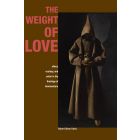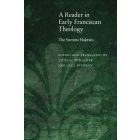The Beauty of the Trinity
A Reading of the Summa Halensis

This book can be opened with

In this book Justin Shaun Coyle remembers the theology of beauty of the forgotten Summa Halensis, an early-thirteenth-century text written by Franciscan friars at the University of Paris. Many scholars vaunt the Summa Halensis—conceived but not drafted entirely by Alexander of Hales (d. 1245)—for its teaching on beauty and its influence on giants of the high scholastic idiom. But few read the text’s teaching theologically—as a teaching about God. The Beauty of the Trinity: A Reading of the Summa Halensis proposes an interpretation of the Summa’s beauty—teaching as deeply and inexorably theological, even trinitarian.
The book takes as its keystone a passage in which the Summa Halensis identifies beauty with the “sacred order of the divine persons.” If beauty names a trinitarian structure rather than a divine attribute, then the text teaches beauty where it teaches trinity. So The Beauty of the Trinity trawls the massive Summa Halensis for beauty across passages largely ignored by the literature. Taking seriously the Summa’s own definition of beauty rather than imposing onto the text modernity’s narrow aesthetic categories allows Coyle to identity beauty nearly everywhere across the text’s pages: in its teaching on the transcendental determinations of being, on the trinity proper, on creation, on psychology, on grace. A medieval text must teach beauty that appreciates beauty theologically beyond the constricted and anachronistic boundaries that often limit study of medieval aesthetics. Readers of medieval theology and theological aesthetics both will find in The Beauty of the Trinity a depiction of how an early scholastic summa thinks beauty according to the mystery of the trinity.
This is an exemplary study. It is also an exquisite specimen of theological reflection. It does so very much to rescue Alexander of Hales’s thought on beauty both from obscurity and from unimaginative scholarly treatments. And it convincingly shows how Alexander’s vision can be appropriated creatively by modern theologians.—David Hart, author of Roland in Moonlight and You Are Gods
Scholars have come to be used to the notion that academic writing has to be on the dull side, as though a flat style guaranteed the objectivity of scholarly discourse. But what if the point of theological writing were not merely to state the “facts” about the teachings of some (frequently obscure) author, but to employ a discussion of these teachings to draw the reader in—in to the beauty of the Christian faith? This goal would call for a different style. Its dynamism would signal thinking rather than settled thought. Its choice of words would steer clear of the well-worn phrases and clichés which stifle curiosity; sometimes the vocabulary might even surprise. It would be pleasantly fresh, an invitation to participate in an intellectual and spiritual journey. Such is Dr. Coyle’s style in this book.
—Philipp W. Rosemann, from the Foreword
A generous but decisive corrective to many previous accounts on the transcendentality of beauty during the later Middle Ages.—Mark D. Jordan, Harvard Divinity School
Justin Shaun Coyle (PhD, Boston College) is Associate Professor of Theology, Church History, and Philosophy and Associate Academic Dean at Mount Angel Seminary in St. Benedict, Oregon. He is a tonsured reader in the Ukrainian Greek Catholic Church.
Foreword by Philipp W. Rosemann / vii
List of Abbreviations / xi
Introduction / 1
Part I: Beauty among the Transcendentals
1 Transcendentals and Trinity / 9
Transcendentals in the Summa Halensis • A Trinitarian Motive
2 Transcendentals as Trinitarian Appropriation / 22
A Grammar of Trinitarian Appropriation • One, True, and Good
as Trinitarian Appropriations
3 Beauty as Transcendental Order / 35
Is Beauty a Transcendental? An Aesthetic Aporia • An Anonymous
Proposal • Beauty as Sacred Order of the Trinity • Beauty as Order
of the Transcendentals
Part II: The Trinity’s Beauty ad intra
4 The Beauty the Trinity Is / 57
Persons and Processions • The Order of the Trinity •
Is Not the Son Beauty, Too?
Part III: The Trinity’s Beauty ad extra
5 The Beauty Creation Is / 77
Creation and Trinitarian Processions • Trinitarian Causality •
Trinitarian Traces • The Beauty of Creation
6 The Beauty the Soul Is / 96
The Soul and Its Powers: A Disputed Question • The Soul and Its Powers
in the Early Halensian School • Brother Alexander on the Imago trinitatis
7 The Beauty Grace Gives / 112
Sin as Antitrinity • Grace’s Trinitarian Condition • The Trinitarian
Structure of Grace • Grace as Trinitarian Enjoyment
Conclusion & ad obiectiones / 131
Acknowledgments / 141
Notes / 143
Bibliography / 201
Index / 221




